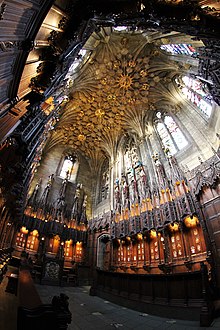Thistle Chapel
In the 19th and early 20th centuries, multiple proposals were made either to refurbish Holyrood Abbey for the Order of the Thistle or to create a chapel within St Giles' Cathedral.
In 1906, after the sons Ronald Leslie-Melville, 11th Earl of Leven donated £24,000 from their late father's estate, Edward VII ordered a new Chapel to be constructed on the south side of St Giles'.
Through the continuing addition of stall plates, crests, and banners for new Knights, the Chapel's tradition of craftsmanship persists to the present day.
A number of critics have emphasised the Chapel's importance as a product of the Arts and Crafts movement, in which the collaborative craftsmanship of individual artisans defines the overall effect.
[2] In the seventeen months after the publication of the warrant, William Bruce oversaw the transformation of the Abbey: an altar and black and white marble floor were added and classical stalls were shipped from London.
Although Graham and Pugin's plans were not acted upon at the time, the same ambition was advanced in 1905, when Ronald Leslie-Melville, 11th Earl of Leven set up a fund of £40,000 to restore Holyrood Abbey for the Order of the Thistle.
Of the major contributors to the Chapel, only Louis Davis – who designed the heraldic stained glass – and the Bromsgrove Guild – who supplied decorative metalwork – were based outside Scotland.
[25][26] Lorimer's design takes inspiration from late 15th century Gothic architecture and, in its form and in its use of curvilinear tracery, displays the influence of George Frederick Bodley.
The same stone was employed by William Burn as ashlar to face the exterior of St Giles' during the restoration of 1829–33 and by Robert Reid for the construction of the Law Courts on the opposite side of Parliament Square.
[26][30] Christopher Hussey argued Lorimer was successful in creating a chapel that "harmonises perfectly with the Cathedral structure as a whole, but fearlessly proclaims its individuality.
[34] Between the south wall of Saint Giles and the north side of the Chapel, a wide flight of steps rises to the east door, which leads to the ante-chapel.
When the Cathedral's partition walls were demolished during the restoration of 1871–1883, William Hay reconstructed the door at the royal entrance at the east end of the church.
[43] Likewise, Lorimer's preference for heraldic angels and foliate bosses may have been inspired by similar stonework in the adjoining Preston Aisle of St Giles'.
The plaque was made by Stewart McGlashan & Sons of Canonmills and consists of a panel of granite with a bronze border and lettering; the Royal Arms of Scotland are formed by inlaid pieces of marble.
[47] The book rest in front of the Sovereign’s stall bears a large panel with the full achievement of the Royal Arms of Scotland; on the ends are the escutcheons of Queen Anne and James VII.
The panelling of the central section above the holy table is the most detailed and contains a sculpture of an allegorical winged figure defeating a dragon which represents evil.
[53] A number of pieces of free-standing wooden furniture were added at the time of the Chapel’s construction: these are the Dean’s chair and book rest and the lectern and reader’s seat.
[53] The table was produced to coincide with Sir John Hatt Noble Graham’s donation of a silver chalice and paten from the collection Ferdinand II of Portugal.
[64] Strachan’s single-light east window depicts Saint Andrew above the Royal Arms of Scotland and beneath two angles who bear his cross and martyr’s crown.
[65] In 1982, small stained glass windows replaced the ventilation grilles in the former boiler room below the Chapel; these were designed by Christian Shaw and depict the days of creation.
[70] Architectural metalwork by other firms includes door locks and hinges by Low & Methven of Lothian Road and external lead piping by W. Dodds & Sons of West Kilburn.
[26] This practice is well-established in the United Kingdom's orders of chivalry, similar plaques have been installed for Knights of the Garter at St George's Chapel, Windsor Castle since the 15th century.
Working at her home studio in Colinton, Traquair used the champlevé technique, setting vitreous enamel over foil to create shimmering, jewel-like surfaces.
After 1911, the stall plates were produced by Elizabeth Kirkwood, who was influenced by Traquair's technique and who also introduced modelling to the helm and mantling of the arms to give them a three-dimensional effect.
[88][89] "It is a remarkable, and was at the time a unique, example of a true revival of the medieval crafts – traditional yet spontaneous; instinct with the Gothic spirit yet unaffected and of its own age.
[90] In the Thistle Chapel, in Stewart Matthew's assessment, "the very essence of Gothic architecture was achieved: an emphasis of the vertical which gives a sense of reaching upwards beyond material confines.
Ranald MacInnes, Miles Glendinning, and Aonghus MacKechnie identify the Thistle Chapel as "the most emphatic example of the nationalist trend in church architecture".
MacInnes, Glendinning, and MacKechnie contrast the Chapel's "ecclesiastical lavishness" and "Rosslyn-like elaboration" with John James Burnet's "simpler evocation of archaic monumentality" and Ramsay Traquair and Reginald Fairlie's revival of the neo-Romanesque trend in 15th century Scottish church architecture.
[91][92] Alongside its importance as a Gothic building, the Thistle Chapel is, in Louise Boreham's words, "an exquisite jewel of the entire Arts and Crafts movement.
Charles Burnett notes that, on completion of the Thistle Chapel, "[the] ancient realm of Scotland had clawed back a major element in the unique identity of the country".



